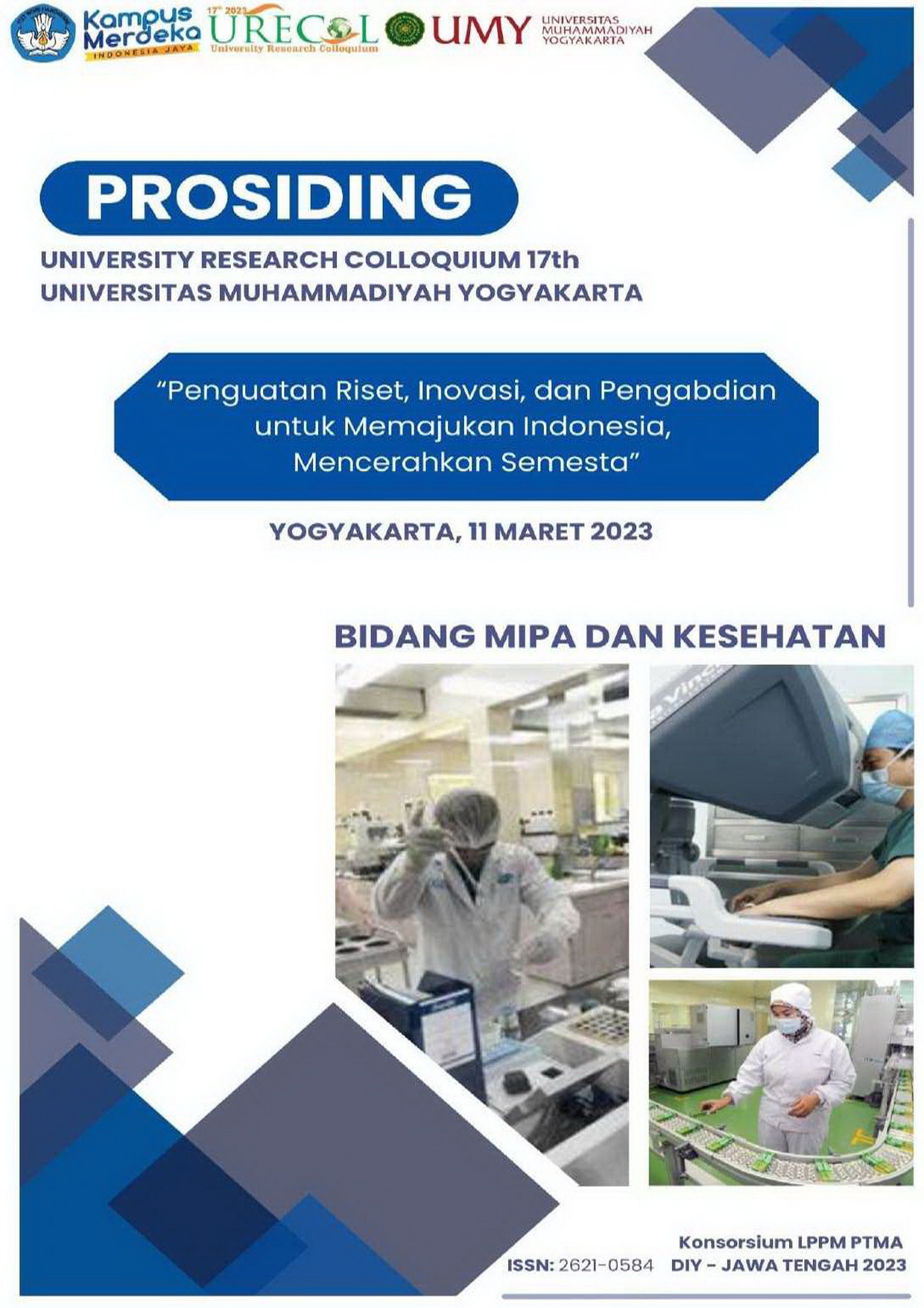Anemia, Chronic Energy Deficiency for Pregnant Women, Non-Exclusive Breastfeeding as Risk Factors for Stunting in Toddlers
Keywords:
Stunting, Anemia, KEK, Exclusive BreastfeedingAbstract
Stunting is a condition in which a child experiences failure to thrive. WHO data for 2020 the prevalence of stunting is 22%. The latest data from the Ministry of Health states that in 2021 the incidence of stunting in Indonesia will be 24.4%. It is suspected that stunting is caused by several factors, namely history of anemia, nutritional status of pregnant women, breastfeeding, young gestation and hypertension in pregnant women. This study aims to determine the relationship between anemia, chronic energy deficiency (CED) in pregnant women and breastfeeding with the incidence of stunting. This type of research is quantitative observational analytic case control approach. The sample is 156 respondents with details of 78 respondents as the case group and 78 other respondents as the control group. Sampling used secondary data that was collected in the medical records of the Jogorogo Health Center through a purposive sampling technique. The results of the chi-square test showed a relationship between anemia and stunting with a p value <0.001 and an OR of 3.45. The results of the bivariate test showed a correlation between KEK and Stunting with a p value <0.001 and an OR of 2.64. There is a correlation between breastfeeding and the incidence of stunting with a p value <0.001 and OR 3.685. In the logistic regression test, the OR result was 0.128 with a p value <0.001. In conclusion, there is a significant correlation between anemia, CED, and breastfeeding with the incidence of stunting.
References
Kementerian Kesehatan RI, “Ini Penyebab Stunting pada Anak,” 2018.
https://www.kemkes.go.id/article/view/18052800006/ini-penyebab-stunting-padaanak.
html (accessed Sep. 26, 2022).
BPK RI, "PERPRES No. 72 Tahun 2021 tentang Percepatan Penurunan Stunting",
https://peraturan.bpk.go.id/Home/Details/174964/perpres-no-72-tahun-2021
(accessed Jan. 31, 2023).
Kementrian Kesehatan RI, “Kementerian Kesehatan Republik Indonesia,” 2021.
https://www.kemkes.go.id/article/view/21012600002/remaja-sehat-komponen-utama-pembangunan-sdm-indonesia.html (accessed Aug. 08, 2022).
Y. Wardita, E. Suprayitno, and E. M. Kurniyati, “Determinan Kejadian Stunting
pada Balita,” J. Heal. Sci. (Jurnal Ilmu Kesehatan), vol. 6, no. 1, pp. 7–12, 2021, doi:
24929/jik.v6i1.1347.
R. Aryani and C. Azizah, “Hubungan Pemberian Asi Ekslusif Dengan Kejadian
Stunting Pada Balita 1-5 Tahun Di Wilayah Kerja UPTD Puskesmas Ulee Kareng
Kecamatan Ulee Kareng Kota Banda Aceh The Relationship of Exclusive Breast
Milk With the Event Stunting in Tolls 1-5 Years Old in Th,” J. Heal. Technol. Med. ,
vol. 8, no. 1, pp. 81–91, 2022.
Kementrian Kesehatan RI, “Cegah Stunting, itu Penting.,” Pus. Data dan Informasi,
Kementeri. Kesehat. RI, pp. 1–27, 2018, [Online]. Available:
https://www.kemkes.go.id/download.php?file=download/pusdatin/buletin/Buletin-
Stunting-2018.pdf
Kementerian Kesehatan RI, “Buletin Jendela Data dan Informasi Kesehatan:
Situasi Balita Pendek (Stunting) di Indonesia,” Kementeri. Kesehat. RI, p. 20, 2020.
M. Karjono and L. Erna D, “Anemia Dan Kurang Energi Kronik (Kek) Sebagai
Faktor Resiko Terjadinya Stanting Diwilayah Kerja Upt Blud Puskesmas Senaru
Kabupaten Lombok Utara,” J. Ilm. Sangkereang, vol. 8, no. 1, pp. 76–79, 2021.
Kementerian kesehatan RI, “Laporan Akuntabilitas Kinerja 2018,” Direkorat Gizi
Masy., vol. 1–52, no. 9, pp. 1689–1699, 2019.
N. Ruaida and O. Soumokil, “Hubungan Status Kek Ibu Hamil Dan Bblr Dengan
Kejadian Stunting Pada Balita Di Puskesmas Tawiri Kota Ambon,” J. Kesehat.
Terpadu (Integrated Heal. Journal) , vol. 9, no. 2, pp. 1–7, 2018, doi:
32695/jkt.v2i9.12.
A. M. Latifah, L. E. Purwanti, and F. I. Sukamto, “HUBUNGAN PEMBERIAN ASI
EKSKLUSIF DENGAN KEJADIAN STUNTING PADA BALITA 1-5 TAHUN
Abstract,” vol. 4, no. 1, pp. 131–142, 2020.
R. Khairunisa, Mitra2(K), C. V. G. Purba1, A. Alamsyah1, and A. R. Abidin1,
“FAKTOR RISIKO IBU PADA SAAT HAMIL DENGAN KEJADIAN STUNTING
PADA ANAK BALITA DI KOTA PEKANBARU Risk Factors Of Mothers During
Pregnancy With Stunting In Children In Pekanbaru City,” vol. 5, no. 3, pp. 150–160,
R. E. Leki, N. K. Sutiari, and I. M. Subrata, “Risiko Anemia Kurang Energi Kronis
Saat Hamil Dan Penambahan Berat Badan Ibu Selama Hamil Yang Tidak Sesuai
Standar IOM Terhadap Kejadian Stunting Pada Balita Usia 24-59 Bulan Di
Kecamatan Lamaknen Selatan,” vol. 5, no. 2, pp. 141–152, 2019.
V. N. Apriningtyas and T. D. Kristini, “Faktor Prenatal yang Berhubungan dengan
Kejadian Stunting Anak Usia 6-24 Bulan,” J. Kesehat. Masy. Indones. , vol. 14, no.
, p. 13, 2019, doi: 10.26714/jkmi.14.2.2019.13-17.
S. Handayani, W. N. Kapota, and E. Oktavianto, “HUBUNGAN STATUS ASI
EKSKLUSIF DENGAN KEJADIAN STUNTING PADA BATITA USIA 24-36
BULAN DI DESA WATUGAJAH KABUPATEN GUNUNGKIDUL,” Med. Respati
J. Ilm. Kesehat., vol. 14, no. 4, p. 287, 2019.
S. A. P. Astuti, Sukmawati, E. Nadya, and F. Feriyani, “Hubungan Riwayat KEK
dan Pemberian ASI Ekslusif dengan Kejadian Stunting pada Balita Usia 24-60
Bulan di Kabupaten Pasaman Tahun 2020,” J. Noncommunicable Dis., vol. 1, no. 2,
p. 61, 2021, doi: 10.52365/jond.v1i2.356.
S. A. S. SJMJ, R. C. Toban, and M. A. Madi, “Hubungan Pemberian ASI Eksklusif
Dengan Kejadian Stunting Pada Balita,” J. Ilm. Kesehat. Sandi Husada, vol. 11, no.
, pp. 448–455, 2020, doi: 10.37010/mnhj.v3i1.498.
Mufdillah, “Pedoman Pemberdayaan Ibu Menyusui pada Program ASI Ekslusif,”
Peduli ASI Ekslusif, pp. 0–38, 2017.
S. Handayani, Gunarmi, and F. Agusman, “HUBUNGAN KADAR
HAEMOGLOBIN, STATUS GIZI DAN JARAK KEHAMILAN PADA IBU HAMIL
TERHADAP KEJADIAN STUNTING,” J. kebidanan, vol. XIV, no. 02, pp. 190–202,
Downloads
Published
How to Cite
Issue
Section
License
Copyright (c) 2023 Dhia Naila Alfatikha, Mohammad Shoim Dasuki

This work is licensed under a Creative Commons Attribution-NonCommercial 4.0 International License.



